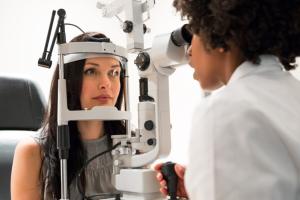
Poor vision isn’t the only indicator of eye disease. In fact, it’s usually the last thing that happens. And, once you start to lose vision, you often can’t get it back.
This is why it is so important to visit your eye doctor regularly. A comprehensive eye exam allows doctors to see things you can’t—so little problems don’t become big ones later on. And, if you’re a contact lens wearer, annual exams are mandatory.
Here’s what you need to know about eye exams:
Who— Everyone needs regular eye exams, regardless of vision correction needs and overall wellness.
What—A comprehensive eye exam may take up to about an hour to an hour and a half and includes a wide array of tests, including refraction, binocular vision testing, color vision testing, dilation with thorough retina assessment, a glaucoma check, slit lamp observation, visual fields assessment, and more. If you wear contact lenses, a contact lens workup is also needed and usually includes additional tests.
Why— Many eye diseases have no symptoms in the early stages, but prompt detection, diagnosis and treatment are important because it can often reduce your risk of permanent vision loss. And, the benefits don’t end there. An eye exam can also sometimes detect systemic conditions, saving more than just your sight! For children, eye exams are especially important. In fact, the American Optometric Association says eye and vision care ought to be given the same level of importance and attention as other standard medical practices, such as dental care and vaccinations.1
When— Adults with no risk factors or family history of eye problems should get an eye exam at least every two years and annually after age 60.2 Kids need a check-up at 6 months, 3 years, before 1st grade, and then annually after that.2
Where— Many schools and workplaces offer free vision screenings, which is very different than a comprehensive eye exam designed to catch a wide array of diseases.1 Establish a relationship with an eye doctor as soon as possible. If you don’t already have one, use our Find An Eye doctor tool and make an appointment today!
Nothing in this blog post is to be construed as medical advice, nor is it intended to replace the recommendations of a medical professional. For specific questions, please see your eye care practitioner.
1. American Optometric Association. Evidence-based clinical practice guideline: Comprehensive pediatric eye and vision examination. Guideline Brief 2017. Available at: https://www.aoa.org/AOA/Documents/Practice%20Management/Clinical%20Guidelines/EBO%20Guidelines/Comprehensive%20Pediatric%20Eye%20and%20Vision%20Exam.pdf
2. American Optometric Association. Recommended Eye Examination Frequency for Pediatric Patients and Adults. Available at: https://www.aoa.org/patients-and-public/caring-for-your-vision/comprehensive-eye-and-vision-examination/recommended-examination-frequency-for-pediatric-patients-and-adults





